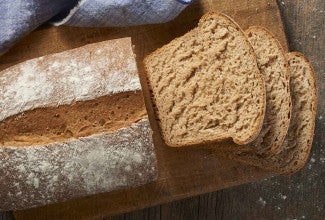Sourdough Pumpernickel Bread
This bread, made without the help of commercial yeast, is a great accompaniment to borscht or any other hearty soup. It's made with whole grain rye flour, a.k.a. pumpernickel. Rye flour has less gluten-forming protein than wheat, and so creates a denser bread. For an even heartier loaf, substitute a cup of whole wheat flour for a cup of the all-purpose.
After you've put the dough together and shaped it, it'll need to rise for 2 or 3 hours. If you make one loaf, it'll need to bake for about 45 minutes. Two loaves will each take about 35 minutes. Take this timing into consideration before you start.


















